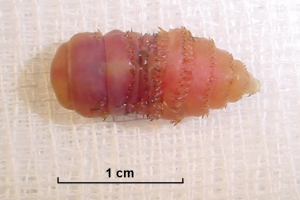The Bot: More Than a Pest
Bots Flies are common in most stables. Often swatted at, but rarely hit, they are a pest poorly tolerated by horse and owner. Bot flies can be much more than just pests, however. The annoyance and distraction they cause can interfere with feeding and affect nutrition. The migration of bot larvae under the skin in mucous membranes causes lesions that may provide openings for infection. Flies also carry diseases that can seriously harm your horse’s health and performance. Without treatment, bots can cause severe damage in the stomach and intestine of your horse.
A Long Life Cycle
Adult bot flies are brown, hairy and bee-like, with one pair of wings, and measure about 3/4". The bot larva is also 3/4" long, with a narrow, hooked end and a broad, rounded body. In the summer months, adult bot flies are a common sight around horses. Yet this adult stage is just a brief part of the bot fly life cycle. Female bot flies have no mouth parts, so they cannot feed. They live on stored reserves only long enough to lay eggs on the hair around a horse's eyes, mouth, nose, or on the legs. Moisture from the skin or from the horse's licking causes the eggs to hatch into larvae.
The Bot Life Cycle
After a three-week developmental period in the mouth, bot fly larvae of both species, Gasterophilus intestinalis and Gasterophilus nasalis, migrate and attach themselves to the mucus lining of the horse's stomach and remain there during the winter. After about 10 months, they detach from the lining and are passed out of the body through the feces. The larvae burrow into the ground and mature. Depending on the conditions, adults emerge in three to 10 weeks. Adult females deposit eggs on the horse's legs, shoulders, chin, throat and lips. Depending on geographic location, the life cycle of bot flies is not fixed to only certain times of the year, and bot larvae can be active in horses anywhere from August to May.
Egg laying begins in early summer. Eggs of the two species differ in color and placement.
G. intestinalis – G. nasalis
G. intestinalis lays up to 1,000 pale-yellow eggs on the horse's forelegs and shoulders. Moisture and friction from the horse's licking itself cause the eggs to hatch in about seven days. After hatching, G. intestinalis larvae are licked into the mouth.
G. nasalis lays about 500 yellow eggs around the chin and throat of the horse. These eggs are not dependent on the horse's licking them to hatch. G. nasalis burrows under the skin to the mouth, wandering through it for about a month before migrating to the stomach for overwintering. Then the cycle begins again.
Signs of Bot Infestation
Horses that show no outward signs of illness can be severely infested, giving no clue to damage occurring inside. However, some horses do show signs of infestation, including an inflamed mouth area and stomach irritation. Infestation with bot larvae may cause ulcers in the stomach lining. If the infestation is severe, the opening from the stomach to the intestines may be blocked, which can cause irritation, ulcers and even colic. The burrowing larvae can cause small tears in the skin, which can become infected.
Treatment for Bots
Traditionally, horses are treated for bots in the fall, after a frost that kills the adult flies, and again in the spring, to rid the stomach of all the larvae. In the past, the treatment was worse than the disease, with extremely toxic chemicals given via stomach tube to the horse. Modern anthelmintics like ivermectin are extremely effective and safe in the treatment of bots and have had an impact on lowering the number of bot flies in areas where good anthelmintic treatment is practiced.

